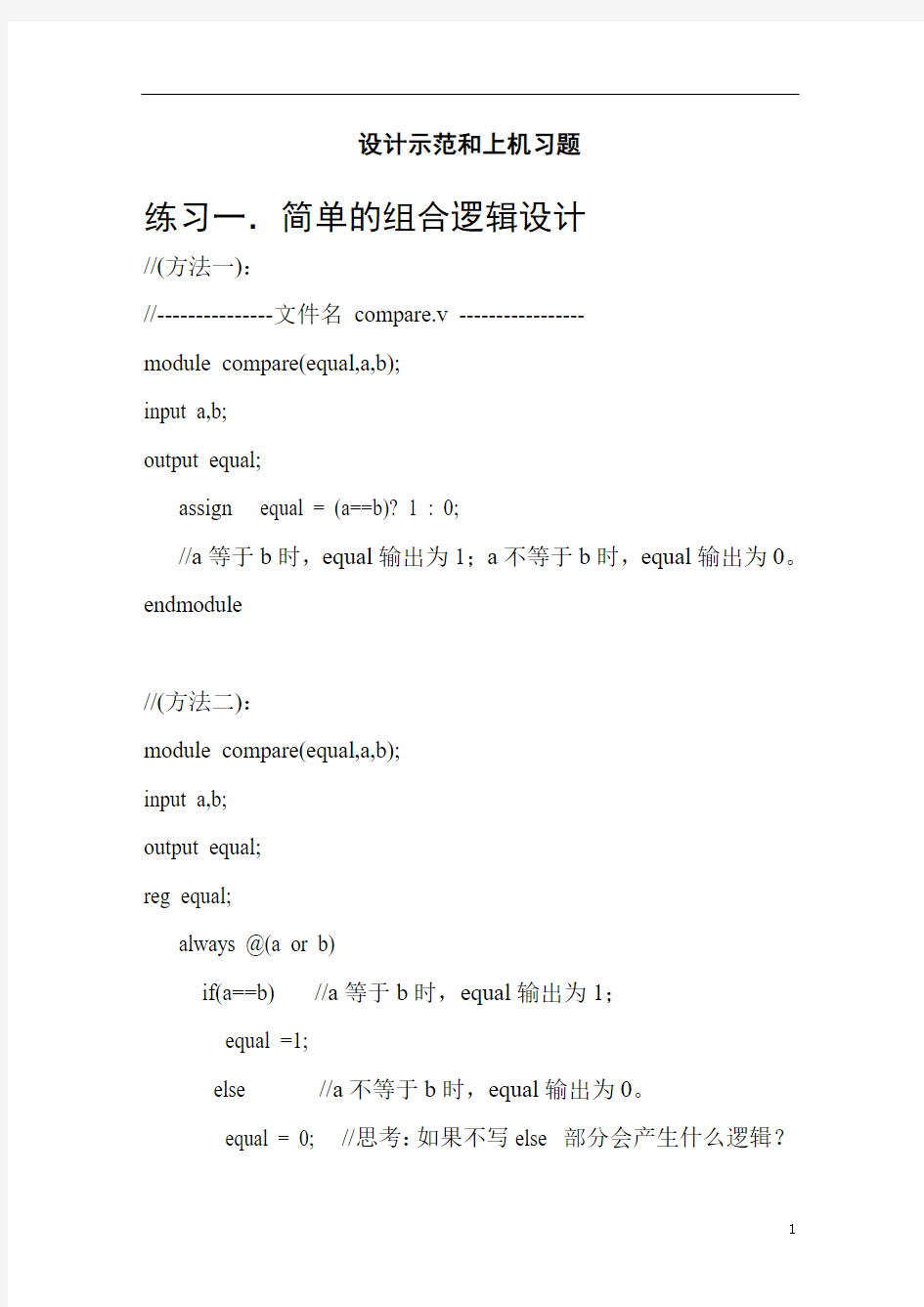Verilog HDL编程举例


设计示范和上机习题
练习一.简单的组合逻辑设计
//(方法一):
//---------------文件名compare.v -----------------
module compare(equal,a,b);
input a,b;
output equal;
assign equal = (a==b)? 1 : 0;
//a等于b时,equal输出为1;a不等于b时,equal输出为0。endmodule
//(方法二):
module compare(equal,a,b);
input a,b;
output equal;
reg equal;
always @(a or b)
if(a==b) //a等于b时,equal输出为1;
equal =1;
else //a不等于b时,equal输出为0。
equal = 0; //思考:如果不写else 部分会产生什么逻辑?
endmodule
//-------------------------------------------------------------
//----------测试模块源代码(方法之一):
`timescale 1ns/1ns // 定义时间单位。
`include "./compare.v" // 包含模块文件。在有的仿真调试环境中并不需要此语句。
//而需要从调试环境的菜单中键入有关模块文件的路径和名称
module t;
reg a,b;
wire equal;
initial // initial常用于仿真时信号的给出。
begin
a=0;
b=0;
#100 a=0; b=1;
#100 a=1; b=1;
#100 a=1; b=0;
#100 a=0; b=0;
#100 $stop; //系统任务,暂停仿真以便观察仿真波
形。
end
compare m(.equal(equal),.a(a),.b(b)); //调用被测试模块t.m
endmodule
//---------- 测试模块源代码(方法之二):-------------------------
`timescale 1ns/1ns // 定义时间单位。
`include "./compare.v" // 包含模块文件。在有的仿真调试环境中并不需要此语句。
//而需要从调试环境的菜单中键入有关模块文件的路径和名称
module t;
reg a,b;
reg clock;
wire equal;
initial // initial常用于仿真时信号的给出。
begin
a=0;
b=0;
clock = 0; //定义一个时钟变量
end
always #50 clock = ~clock; //产生周期性的时钟
always @ (posedge clock) //在每次时钟正跳变沿时刻产生不同的a 和 b
begin
a = {$random}%2; // 每次a是0还是1是随机的。
b = {$random}%2; // 每次b是0还是1是随机的。
end
initial
begin #100000 $stop; end //系统任务,暂停仿真以便观察仿真波形。
compare m(.equal(equal),.a(a),.b(b)); //调用被测试模块t.m
endmodule
练习二. 简单分频时序逻辑电路的设计
//------------------------- 文件名:half_clk.v --------------------------------
module half_clk(reset,clk_in,clk_out);
input clk_in,reset;
output clk_out;
reg clk_out;
always @(posedge clk_in)
begin
if(!reset) clk_out=0;
else clk_out=~clk_out;
end
endmodule
//---------- 测试模块的源代码:------------------------
//------------------- 文件名top.v -----------------------------
`timescale 1ns/100ps
`define clk_cycle 50
module top;
reg clk,reset;
wire clk_out;
always #`clk_cycle clk = ~clk; //产生测试时钟
initial
begin
clk = 0;
reset = 1;
#10 reset = 0;
#110 reset = 1;
#100000 $stop;
end
half_clk m0(.reset(reset),.clk_in(clk),.clk_out(clk_out)); endmodule
练习三. 利用条件语句实现计数分频时序电路
//-------------- 模块源代码:-----------------------------
// --------------- fdivision.v -----------------------------
module fdivision(RESET,F10M,F500K);
input F10M,RESET;
output F500K;
reg F500K;
reg [7:0]j;
always @(posedge F10M)
if(!RESET) //低电平复位。
begin
F500K <= 0;
j <= 0;
end
else
begin
if(j==19) //对计数器进行判断,以确定F500K 信号是否反转。
begin
j <= 0;
F500K <= ~F500K;
end
else
j <= j+1;
end
endmodule
//------------- 测试模块源代码:------------------------- //--------------- fdivision_Top.v ------------------------ `timescale 1ns/100ps
`define clk_cycle 50
module division_Top;
reg F10M,RESET;
wire F500K_clk;
always #`clk_cycle F10M = ~ F10M;
initial
begin
RESET=1;
F10M=0;
#100 RESET=0;
#100 RESET=1;
#10000 $stop;
end
fdivision fdivision
(.RESET(RESET),.F10M(F10M),.F500K(F500K_clk)); endmodule
练习四. 阻塞赋值与非阻塞赋值的区别// ---------- 模块源代码:----------------------
// ------------- blocking.v ---------------
module blocking(clk,a,b,c);
output [3:0] b,c;
input [3:0] a;
input clk;
reg [3:0] b,c;
always @(posedge clk)
begin
b = a;
c = b;
$display("Blocking: a = %d, b = %d, c = %d ",a,b,c);
end
endmodule
//------------- non_blocking.v -------------------
module non_blocking(clk,a,b,c);
output [3:0] b,c;
input [3:0] a;
input clk;
always @(posedge clk)
begin
b <= a;
c <= b;
$display("Non_Blocking: a = %d, b = %d, c = %d ",a,b,c); end
endmodule
// ---------- 测试模块源代码:--------------------------
//------------- compareTop.v -----------------------------
`timescale 1ns/100ps
`include "./blocking.v"
`include "./non_blocking.v"
module compareTop;
wire [3:0] b1,c1,b2,c2;
reg [3:0] a;
initial
begin
clk = 0;
forever #50 clk = ~clk; //思考:如果在本句后还有语句,能否执行?为什么?
end
initial
begin
a = 4'h3;
$display("____________________________");
# 100 a = 4'h7;
$display("____________________________");
# 100 a = 4'hf;
$display("____________________________");
# 100 a = 4'ha;
$display("____________________________");
# 100 a = 4'h2;
$display("____________________________");
# 100 $display("____________________________");
$stop;
end
non_blocking non_blocking(clk,a,b2,c2); blocking blocking(clk,a,b1,c1);
endmodule
练习五. 用always块实现较复杂的组合逻辑电路
//---------------文件名alu.v --------------------------
`define plus 3'd0
`define minus 3'd1
`define band 3'd2
`define bor 3'd3
`define unegate 3'd4
module alu(out,opcode,a,b);
output[7:0] out;
reg[7:0] out;
input[2:0] opcode;
input[7:0] a,b; //操作数。
always@(opcode or a or b) //电平敏感的always块
begin
case(opcode)
`plus: out = a+b; //加操作。
`minus: out = a-b; //减操作。
`band: out = a&b; //求与。
`bor: out = a|b; //求或。
`unegate: out=~a; //求反。
default: out=8'hx; //未收到指令时,输出任意态。
endcase
end
endmodule
//----------- 指令译码器的测试模块源代码:--------------
//------------- alutest.v -----------------
`timescale 1ns/1ns
`include "./alu.v"
module alutest;
wire[7:0] out;
reg[7:0] a,b;
reg[2:0] opcode;
parameter times=5;
initial
begin
a={$random}%256; //Give a radom number blongs to [0,255] .
b={$random}%256; //Give a radom number blongs to
[0,255].
opcode=3'h0;
repeat(times)
begin
#100 a={$random}%256; //Give a radom number.
b={$random}%256; //Give a radom number.
opcode=opcode+1;
end
#100 $stop;
end
alu alu1(out,opcode,a,b);
endmodule
练习六. 在Verilog HDL中使用函数
//--------------- 模块源代码:---------------
//----------- 文件名tryfunct.v --------------------
module tryfunct(clk,n,result,reset);
output[31:0] result;
input[3:0] n;
input reset,clk;
reg[31:0] result;
always @(posedge clk) //clk的上沿触发同步运算。
begin
if(!reset) //reset为低时复位。
result<=0;
else
begin
result <= n * factorial(n)/((n*2)+1);
end //verilog在整数除法运算结果中不考虑余数
end
function [31:0] factorial; //函数定义,返回的是一个32位的数
input [3:0] operand; //输入只有一个四位的操作数
reg [3:0] index; //函数内部计数用中间变量begin
factorial = operand ? 1 : 0; //先定义操作数为零时函数的输出为零,不为零时为1
for(index = 2; index <= operand; index = index + 1)
factorial = index * factorial; //表示阶乘的算术迭代运算
end
endfunction
endmodule
//-------------- 测试模块源代码:------------------
`include "./tryfunct.v"
`timescale 1ns/100ps
`define clk_cycle 50
module tryfuctTop;
